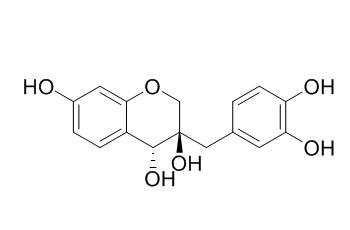Episappanol
Episappanol has anti-inflammatory activity , it can significantly inhibit the secretion of the pro-inflammatory cytokines interleukin (IL-6) and tumor necrosis factor-alpha (TNF-α).
Inquire / Order:
manager@chemfaces.com
Technical Inquiries:
service@chemfaces.com
Tel:
+86-27-84237783
Fax:
+86-27-84254680
Address:
1 Building, No. 83, CheCheng Rd., Wuhan Economic and Technological Development Zone, Wuhan, Hubei 430056, PRC
Providing storage is as stated on the product vial and the vial is kept tightly sealed, the product can be stored for up to
24 months(2-8C).
Wherever possible, you should prepare and use solutions on the same day. However, if you need to make up stock solutions in advance, we recommend that you store the solution as aliquots in tightly sealed vials at -20C. Generally, these will be useable for up to two weeks. Before use, and prior to opening the vial we recommend that you allow your product to equilibrate to room temperature for at least 1 hour.
Need more advice on solubility, usage and handling? Please email to: service@chemfaces.com
The packaging of the product may have turned upside down during transportation, resulting in the natural compounds adhering to the neck or cap of the vial. take the vial out of its packaging and gently shake to let the compounds fall to the bottom of the vial. for liquid products, centrifuge at 200-500 RPM to gather the liquid at the bottom of the vial. try to avoid loss or contamination during handling.
Front Plant Sci.2020, 11:630.
Appl. Sci.2023, 13(2), 860.
Metabolites2022, 12(6),507.
Antioxidants (Basel).2023, 12(5):1111.
Processes2020, 8(12),1540.
Cancer Lett. 2023, 18:216584.
Molecules.2022, 27(21):7514.
Biol Pharm Bull.2018, 41(11):1685-1693
Nat Prod Commun.2018, 10.1177
Food Chem.2023, 404(Pt A):134517.
Related and Featured Products
Food Funct. 2016 Mar;7(3):1671-9.
Compounds from Caesalpinia sappan with anti-inflammatory properties in macrophages and chondrocytes.[Pubmed:
26951869]
The heartwood of Caesalpinia sappan is a traditional ingredient of food and beverages in South East Asia and has been used in traditional medicine as an analgesic and anti-inflammatory drug or to promote blood circulation. Scientific studies have confirmed different bioactivities associated with its use.
METHODS AND RESULTS:
Here, five fractions were isolated from the ethanolic extract of C. sappan heartwood, including Episappanol (1), protosappanin C (2), brazilin (3), (iso-)protosappanin B (4) and sappanol (5) using high-performance liquid chromatography (HPLC). All compounds were tested for their anti-inflammatory effects in two different cell lines. Cytokine concentrations in the cell supernatant were determined using enzyme-linked immunosorbent assay (ELISA), and mRNA levels were measured using reverse-transcription quantitative polymerase chain reaction (RT-qPCR). In lipopolysaccharide-stimulated macrophages, all compounds significantly inhibited the secretion of the pro-inflammatory cytokines interleukin (IL-6) and tumor necrosis factor-alpha (TNF-α). Sappanol (5) increased the secretion of the anti-inflammatory IL-10. In IL-1β-stimulated chondrocytes, all fractions reduced the mRNA expression and the secretion of the pro-inflammatory cytokines IL-6 and TNF-α. The highest anti-inflammatory effect was found for brazilin (3) in both cell lines. Of note, this is the first study which shows the anti-inflammatory effect of sappanol and Episappanol.
CONCLUSIONS:
This study provides evidence for the efficacy of the traditional use of C. sappan as an anti-inflammatory remedy. Given the high prevalence of inflammation-related pathologies including arthritis, and the urgent need to clinically intervene with these diseases, the anti-inflammatory activity of diverse compounds from C. sappan may be of interest for the development of complementary and alternative treatment strategies.



